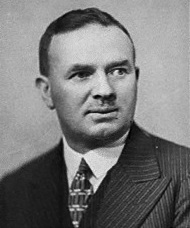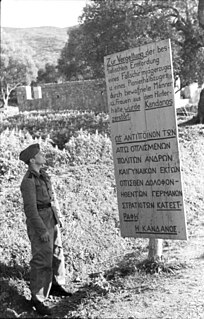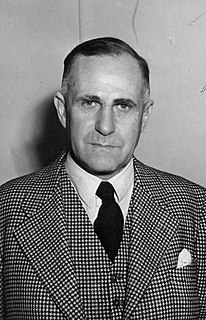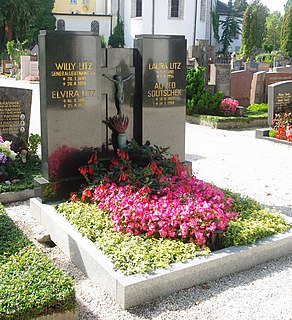 W
WThe Battle of Crete was fought during the Second World War on the Greek island of Crete. It began on the morning of 20 May 1941, when Nazi Germany began an airborne invasion of Crete. Greek and other Allied forces, along with Cretan civilians, defended the island. After one day of fighting, the Germans had suffered heavy casualties and the Allied troops were confident that they would defeat the invasion. The next day, through communication failures, Allied tactical hesitation, and German offensive operations, Maleme Airfield in western Crete fell, enabling the Germans to land reinforcements and overwhelm the defensive positions on the north of the island. Allied forces withdrew to the south coast. More than half were evacuated by the British Royal Navy and the remainder surrendered or joined the Cretan resistance. The defence of Crete evolved into a costly naval engagement; by the end of the campaign the Royal Navy's eastern Mediterranean strength had been reduced to only two battleships and three cruisers.
 W
WThe 1st Parachute Division was an elite German military parachute-landing division that fought during World War II. A division of paratroopers was termed a Fallschirmjäger Division. For reasons of secrecy, it was originally raised as the 7th Air Division, or Flieger-Division, before being renamed and reorganized as the 1st Parachute Division in 1943.
 W
WThe 11th Day: Crete 1941 is a 2005 documentary film featuring eyewitness accounts from survivors of the Battle of Crete during World War II. The film was created by producer-director Christos Epperson and writer-producer Michael Epperson, and funded by Alex Spanos. Among the eyewitnesses interviewed are British SOE operative and famous travel writer Patrick Leigh Fermor, along with George Doundoulakis, and Cretan Resistance hero George Tzitzika. The film also includes historical commentary and analysis by Chase Brandon of the CIA and Professor Andre Gerolymatos of Simon Fraser University.
 W
WThe Battle of 42nd Street was a battle fought during World War II on the Greek island of Crete. On 20 May, Nazi Germany launched an airborne invasion of Crete. A week later, after the British and Commonwealth forces defending the island had been forced to withdraw towards Chania, a force of several understrength Australian and New Zealand infantry battalions established a defensive line along the Hania to Tsikalaria road (Tsikalarion) south-east of Chania, forming a rearguard for the withdrawing troops. On 27 May, as a German battalion advanced towards the road, the Anzac defenders carried out a bayonet charge that inflicted heavy casualties on the German attackers, which forced them to withdraw and briefly halted the German advance.
 W
WThe Battle of Maleme was one of three main battles that occurred in the Battle of Crete against the Fallschirmjäger, in the Nazi German Mediterranean campaign in 1941. The overall plan was to conquer Crete as part of Operation Merkur, with German Paratroopers landing in three main areas, Heraklion, Maleme and Rethymno. The operation relied on German airborne troops, both paratroopers and in gliders. Due to a mistake, and despite being in a superior position, New Zealand troops abandoned a strategic hill, leaving it to the Germans, and then lost the airport. The airport was then used by the Germans to transport in more troops which saw the whole island lost to the Germans.
 W
WMajor General Ian Ross Campbell, was an Australian soldier and businessman. He served during the Second World War and Korean War.
 W
WThe Fallschirmjäger memorial is a German war memorial for German parachutists who fell during the ten-day Battle of Crete in World War II. The memorial, known to Cretans as the German bird (Greek: Γερμανικό πουλί, Germaniko pouli) or the Evil bird , was erected in 1941 by the occupation forces and is located about three kilometers west of Chania on the road to Agii Apostoli.
 W
WBrigadier James Hargest, was an officer of the New Zealand Military Forces, serving in both the First and Second World Wars. He was a Member of New Zealand's Parliament from 1931 to 1944, representing firstly the Invercargill and then the Awarua electorates.
 W
WRichard Heidrich was a German paratroop general during World War II. He was a recipient of the Knight's Cross of the Iron Cross with Oak Leaves and Swords of Nazi Germany.
 W
WThe Battle of Heraklion was part of the Battle of Crete, fought during World War II on the Greek island of Crete between 20 and 30 May 1941. British, Australian and Greek forces of 14th Infantry Brigade, commanded by Brigadier Brian Chappel, defended Heraklion port and airfield against a German paratrooper attack by the 1st Parachute Regiment of the 7th Air Division, commanded by Colonel Bruno Bräuer.
 W
WIn Which We Serve is a 1942 British patriotic war film directed by Noël Coward and David Lean. It was made during the Second World War with the assistance of the Ministry of Information.
 W
WThe Razing of Kandanos refers to the complete destruction of the village of Kandanos in Western Crete (Greece) and the killing of about 180 of its inhabitants on 3 June 1941 by German occupying forces during World War II.
 W
WMajor General Sir Howard Karl Kippenberger,, known as "Kip", was an officer of the New Zealand Military Forces who served in the First and Second World Wars.
 W
WThe Massacre of Kondomari was the execution of male civilians from the village of Kondomari in Crete by an ad hoc firing squad consisting of German paratroopers on 2 June 1941 during World War II. The shooting was the first of a series of reprisals in Crete. It was orchestrated by Generaloberst Kurt Student, in retaliation for the participation of Cretans in the Battle of Crete which had ended with the surrender of the island two days earlier. The massacre was photographed by Franz-Peter Weixler, a German army war propaganda correspondent, whose negatives were discovered 39 years later in the Federal German archives by a Greek journalist.
 W
WAugust Krakau was a German general in the Wehrmacht during World War II who commanded the 7th Mountain Division. He was a recipient of the Knight's Cross of the Iron Cross of Nazi Germany.
 W
WMaleme Airport is an airport situated at Maleme, Crete. It has two runways with no lights. The airport has closed for commercial aviation, but the Chania Aeroclub continues to use it.
 W
WLieutenant General Sir Edward Puttick, was an officer who served with the New Zealand Military Forces during the First and Second World Wars. The first New Zealand-born soldier to reach the rank of lieutenant general, he was Chief of the General Staff of the New Zealand Military Forces from 1941 to 1945.
 W
WThe Battle of Rethymno was part of the Battle of Crete, fought during World War II on the Greek island of Crete between 20 and 29 May 1941. Australian and Greek forces commanded by Lieutenant-colonel Ian Campbell defended the town of Rethymno and the nearby airstrip against a German paratrooper attack by the 2nd Parachute Regiment of the 7th Air Division commanded by Colonel Alfred Sturm.
 W
WRaymond Ladais Sandover, was a brigadier in the Australian Army. During the Second World War, he commanded the 2/11th Battalion from 1941 to 1943 and the 6th Australian Infantry Brigade between 1943 and 1945.
 W
WKurt Arthur Benno Student was a German general in the Luftwaffe during World War II. An early pioneer of airborne forces, Student was in overall command of developing a paratrooper force to be known as the Fallschirmjäger, and as the most senior member of the Fallschirmjäger, commanded it throughout the war. Student led the first major airborne attack in history, the Battle for The Hague, in May 1940. He also commanded the Fallschirmjägers in its last major airborne operation, the invasion of Crete in May 1941. The operation was a success despite German losses, and led the Allies to hasten the training and development of their own airborne units.
 W
WAlfred Sturm was a German general during World War II.
 W
WWillibald Utz was a German general during World War II who commanded several divisions. He was a recipient of the Knight's Cross of the Iron Cross.